

|
|
|
|
|
Abbreviations used in this listing:
|
| Ostrich Struthio camelus | Widespread and seen daily in open dry country away from the coast (up to 120/day in KGNP); introduced birds seen at Cape of Good Hope | |
| Jackass Penguin Spheniscus demersus * | NE/
VU |
The breeding colony at Boulders Bay in Simonstown still had several nests with half-grown young. Scattered birds seen elsewhere along the coast from Cape Town to Lamberts Bay (a dozen at the gannetry at the latter spot). This proved to be my 5000th bird and represents having seen essentially half of the birds in the world; see a separate page on this milestone with lots of info about the penguins. |
| Little Grebe Tachybaptus ruficollis | Common during the period visit to Strandfontein; a few more at Bloubergstrand pond and on the Orange River near Upington | |
| Great-crested Grebe Podiceps cristatus | Four at Bloubergstrand pond | |
| Black-browed Albatross Thalassarche melanophris | Common offshore during the pelagic trip (est. 150) | |
| Shy Albatross Thalassarche cauta | Common offshore during the pelagic trip (est. 130) | |
| Yellow-nosed Albatross Thalassarche (chlororhynchos) carteri * | VU | Small numbers (est. 30) but close views on pelagic trip. All were of the white-headed Indian Ocean population that may represent a separate species (T. carteri) from the gray-headed Atlantic Ocean populations |
| Southern (Antarctic) Giant-Petrel Macronectes giganteus * | VU | Six cameto chew on the bait tossed out for sharks off Dyer Island; three more were offshore during my pelagic trip. Some recent biochemical studies suggest that the two giant-petrels are not well differentiated and should be considered the same species |
| Northern (Hall's) Giant-Petrel Macronectes halli * | NT | One photographed at close range at the shark bait off Dyer Island. A bird following the trawler offshore looked to be this taxa to me but others were more cautious on that i.d. |
| Cape (Pintado) Petrel Daption capense | Common offshore during pelagic trip (est. 300); another was inshore Dyer Island during our shark trip and cruised right be our little boat | |
| Antarctic Prion Pachyptila desolata * | Only a half-dozen seen during the pelagic trip; none stuck around for close views | |
| White-chinned Petrel Procellaria aequinoctialis | VU | Very common offshore on pelagic trip (est. 600); some had additional patches of white on the face or nape. A dozen were also close to our boats during the shark trip off Dyer Island |
| Sooty Shearwater Puffinus griseus | Very common offshore on pelagic trip (est. 800) | |
| Wilson's Storm Petrel Oceanites oceanicus | Common offshore during pelagic trip (est. 200); some were exceedingly close and photographable | |
| Great White Pelican Pelecanus onocrotalus | A half-dozen in flight over Stranfountain at dusk; a few more were at West Coast NP and then 50+ were on Avis Dam in Windhoek | |
| Cape Gannet Morus capensis * | NE/
VU |
Conspicuous offshore during pelagic trip (est. 80). We saw thousands at the gannetry at Lamberts Bay |
| Long-tailed Cormorant Phalacrocorax africanus | One flew down the Orange River upstream of Augrabies Falls; none seen again until encountered daily (up to 100/day) in Okavango Delta | |
| Crowned Cormorant Phalacrocorax coronatus * | NE/'
NT |
Local and in small numbers along peninsular coast south of Cape Town |
| Bank Cormorant Phalacrocorax neglectus * | E/
VU |
We had nice views of several (including nesting birds) among the fur-seal colony on Dyer Island. Another nesting colony of 30+ birds was visited off Cape Point enroute home from the pelagic trip |
| Great (White-breasted) Cormorant Phalacrocorax carbo lucidus | Encountered daily along the coast (up to 30/day) and often roosting with the following species. About 80 more were at Avis Dam in Windhoek | |
| Cape Cormorant Phalacrocorax capensis * | NE | The common coastal cormorant with hundreds seen daily (none inland) |
| Darter Anhinga rufa | A few along the Orange River around Augrabies Falls (and Richard saw another near Cape Town) but then common daily in the Okavango Delta |

Bank Cormorant on nests surrounded by Cape Fur Seals on Dyer I. |
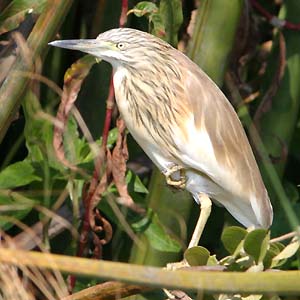
Squacco Heron Okavango River, Botswana |
| Little Egret Egretta garzetta | Common daily in the Okavango Delta | |
| Intermediate Egret Egretta intermedia | We didn't look very hard but saw one in Cape Town vicinity and a few more at Mahango Reserve (Namibia) and Okavango Delta (Botswana) | |
| Great Egret Ardea alba | Pretty much the same as preceding species:one in Cape Town vicinity and a few more at Mahango Reserve (Namibia) and Okavango Delta (Botswana) | |
| Grey Heron Ardea cinerea | Just a few scattered birds around Cape Town and near Augrabies Falls | |
| Black-headed Heron Ardea melanocephala | There was a small roost seen daily in Augrabies Falls NP; a couple elsewhere along the Orange River | |
| Goliath Heron Ardea goliath | Just three on the trip: one on Orange River in South Africa and a couple in the Okavango Delta | |
| Purple Heron Ardea purpurea | A small number (including 8 in flight at dusk) in the Okavango Delta | |
| Cattle Egret Bubulcus ibis | Small flocks daily in Cape Town vicinity; a few more near Upington and in Okavango Delta | |
| Squacco Heron Ardeola ralloides | Our first sighting of the trip was across the Kavango River — and in Angola — from our Rundu lodge; then common daily in Okavango Delta were it was the most common heron in papyrus (up to 300/day) | |
| Rufous-bellied Heron Ardeola rufiventris | One flight down the Kavango River in front of N'kwazi Camp near Rundu | |
| Striated Heron Butorides striatus | Common daily in Caprivi Strip and Okavango Delta (up to 50/day) | |
| White-backed Night-Heron Gorsachius leuconotus * | We saw two birds — one adult and one juvenal — at day roosts along the Okavango River near Xaro Camp. Both birds were roosting in very thick riverine thickets and were difficult to view from our little boats (although we eventually had good quick views). Photography was hopeless | |
| Little Bittern Ixobrychus minutus | We had four different birds flush from the papyrus as we cruised the Okavango Delta | |
| Hamerkop Scopus umbretta | Two birds (and one old nest) were all that we saw this trip; all in Okavango Delta |

Yellow-billed Stork Okavango Delta |

Black Stork near Brandvlei, South Africa |
| Yellow-billed Stork Mycteria ibis | Faily common in Okavango Delta flood-plains (6-50/day) | |
| African Openbill Anastomus lamelligerus | Common in the flooded fields along Okavango River (30-100/day) | |
| Black Stork Ciconia nigra | A single bird in flight -- far from water-- over open karoo near Brandvlei | |
| Marabou Stork Leptoptilos crumeniferus | Surprisingly few: a couple in Etosha NP and two more in Caprivi Strip | |
| Glossy Ibis Plegadis falcinellus | A small flock (15) in one flooded Okavango Delta field | |
| Hadada Ibis Bostrychia hagedash | A few daily around Cape Town vicinity and at Augrabies Falls NP | |
| Sacred Ibis Threskiornis aethiopicus | The common and widespread ibis in good numbers around Cape Town and again in the Okavango Delta | |
| African Spoonbill Platalea alba | One spotted during a drive somewhere east of Cape Town; four in a flooded Okavango Delta field | |
| Greater Flamingo Phoenicopterus ruber | At least 300 in the lagoon at West Coast NP | |
| Lesser Flamingo Phoenicopterus minor | NT | Many fewer (~30) at West Coast NP |
| White-faced Whistling Duck Dendrocygna viduata | Big herds at Mahango Reserve in the Okavango flooded plain | |
| Maccoa Duck Oxyura maccoa | Four at Strandfontein ponds | |
| Egyptian Goose Alopochen aegyptiacus | Widespread in small numbers whereverthere was water in South Africa and Namibia (but none in the Okavango Delta) | |
| South African Shelduck Tadorna cana * | E | A pair or two found on 6-8 small ponds from Cape Town to southern Namibia; a pair on a tiny quarry pond near Fish River Canyon had precocial young |
| Spur-winged Goose Plectropterus gambensis | Common in flooded Okavango Delta fields; a few also in West Coast NP | |
| Comb (Knob-billed) Duck Sarkidiornis melanotos | A few scattered birds in n. Namibia (e.g. Etosha) to Okavango Delta | |
| African Pygmy-Goose Nettapus auritus | Lovely pairs of these delicate waterfowl were seen on quick backwaters off the Okavango Delta on two days | |
| Cape Teal Anas capensis | Just 2-3 seen most days in Cape Town vicinity | |
| African Black Duck Anas sparsa | Four were on a tributary of the Orange River during a drive in Augrabies Falls NP | |
| Yellow-billed Duck Anas undulata | A few daily in Cape Town vicinity (e.g. Cape of Good Hope) and a few more on Orange River near Upington | |
| Cape Shoveller Anas smithii | NE | Flocks at Strandfontein and Bloubergstrand pond |
| Red-billed Duck Anas erythrorhyncha | Flocks at Strandfontein; five more at a waterhole in Etosha NP | |
| Southern Pochard Netta erythrophthalma | Flock (~60) at Strandfontein |
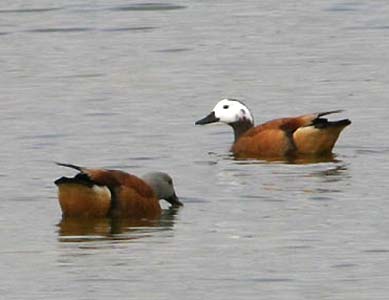
South African Shelduck West Coast NP, South Africa |
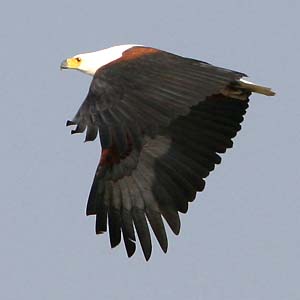
African Fish Eagle Okavango Delta |
| Secretarybird Sagittarius serpentarius | Widely scattered individuals:one not far from Lamberts Bay in West Cape Province (where we were told it is scarce); 2-3 daily on drives in Kalahari-Gemsbok NP; and 2-3 daily on drives in grasslands of Etosha NP | |
| Black-shouldered Kite Elanus caeruleus | Very widespread: recorded on15 of 28 days from Cape to Kalahari and across n. Namibia. | |
| African Fish Eagle Haliaeetus vocifer | A couple at Avis Dam in Windhoek; a few daily in Okavango Delta | |
| Hooded Vulture Necrosyrtes monachus | One seen at a carcass in EtoshaNP | |
| White-backed Vulture Gyps africanus | The widespread vulture (but in low numbers); more were concentrated in KGNP and Etosha than elsewhere | |
| Lappet-faced Vulture Torgos tracheliotus | VU | One spotted from the car enroute to Etosha NP and two more seen during the drive back to Windhoek from Waterberg NP |
| Black-breasted Snake-Eagle Circaetus pectoralis | Scattered birds here and there in thornveld: KGNP and Etosha and various drives around n. Namibia | |
| Brown Snake-Eagle Circaetus cinereus | A pair in flight over open woodlandin the Caprivi Strip | |
| Western Banded Snake-Eagle Circaetus cinerascens | Two singles perched in woodland near Xaro Camp on Okavango River | |
| Bateleur Terathopius ecaudatus | Just 1-2 birds seen on 7 days: KGNP and Etosha and Caprivi Strip had most of them | |
| African Marsh-Harrier Circus ranivorus | One at Strandfontein; others saw another at West Coast NP | |
| Black Harrier Circus maurus * | E/
VU |
A male in flight at some distance in West Coast NP was it |
| African Harrier-Hawk Polyboroides typus | Single birds on 2 days in deciduous woods on Caprivi Strip | |
| Dark Chanting-Goshawk Melierax metabates | Three different birds seen in the deciduous woodland on the Caprivi Strip. This widespread African species (occurs to east Africa) reaches the "southern Africa" region only in this vicinity | |
| Pale Chanting Goshawk Melierax canorus * | NE | Common and widespread in arid thornscrub. Once we had left the coast it was recorded daily except in Augrabies Falls NP and in the Okavango Delta |
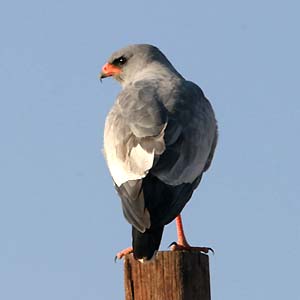
Pale Chanting Goshawk north of Brandvlei, South Africa |
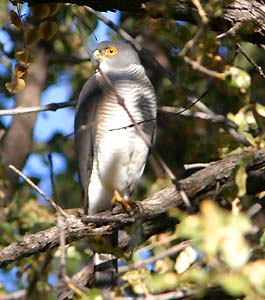
Little Sparrowhawk Watereberg NP, Namibia |
| Gabar Goshawk Melierax gabar | One seen enroute to Etosha NP from Uis | |
| African Goshawk Accipiter tachiro | A pair doing courtship tumbles and vocalizations at Kirstenbosch Gardens near Cape Town | |
| Shikra Accipiter badius | One perched near the Okaukuejo waterhole in Etosha; another seen in flight at N'kwazi Camp on Kavango River; a probable third was in the Caprivi Strip | |
| Little Sparrowhawk Accipiter minullus | One perched very close to us at Waterberg NP in response to Richard's whistles. We initially hoped it would be Ovampo Sparrowhawk A. ovampensis (a potential lifer for all of us) as it was barred gray below but the size and details of eye color andtail pattern proved to support only A. minullus. | |
| Forest Buzzard Buteo trizonatus * | E | This is a recent split from Common Buzzard B. buteo (that species is a migrant to southern Africa in the northern winter/ southern summer). Forest Buzzard is a resident of woodlands near the Cape. We were lucky to see one in flight over Kirstenbosch Gardens |
| Augur Buzzard Buteo augur | This common east African species is scarce and local in southern Africa. We had a single bird in flight during the drive between Spitzkoppe and Erongo Wildness Lodge (as was true for many raptorsfirst seen while driving; it was Rita to spot it first) | |
| Jackal Buzzard Buteo rufofuscus * | E | A single bird near Rooiels on the coast but then daily in the open country from Augrabies Falls to KGNP to Fish River Canyon (yet I never managed a good photo) |
| Tawny Eagle Aquila rapax | Just a few scattered birds: we found a nest-building pair in KGNP and had a couple others in flight in northern Namibia (spotted on long drives through open country) | |
| Verreaux's (Black) Eagle Aquila verreauxii | Three observations of this spectacular raptor: one soaring along cliffs in Paleisheuwel Canyon; a pair at a nest on a vertical cliff face in Augrabies Falls NP; and one foraging along cliffs in Waterberg Nat'l Park. This eagle specializes on rock hyraxes |
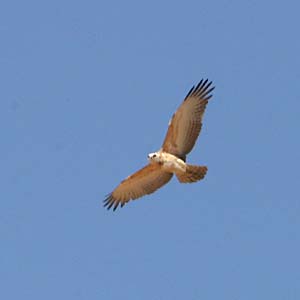
Black-chested Snake-Eagle [juv] Kalahari-Gemsbok NP |
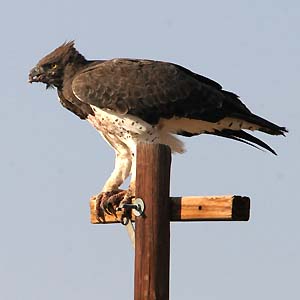
Martial Eagle near Brandvlei, South Africa |
| African Hawk-Eagle Hieraaetus fasciatus | Three observations: a pair circling in the Erongo Mountains; an adult in Waterberg NP; and an immature perched in Daan Viljoen Reserve outside Windhoek | |
| Booted Eagle Hieraaetus pennatus | A pair were working the cliffs downstream from Augrabies Falls; in KGNP we saw single birds on two different days | |
| Martial Eagle Polemaetus bellicosus | We would see four individuals of this huge eagle: two perched on poles in the Brandvlei vicinity; another in flight in KGNP; and another in flight near Fish River Canyon (Namibia) | |
| Pygmy Falcon Polihierax semitorquatus | We actually had quite a few of these little falcons that are so closely associated with Social Weaver nests in southern Africa. We had birds daily in KGNP (up to 8/day) witha few more scattered toward Augrabies Falls and Fish River Canyon | |
| Eurasian (Rock) Kestrel Falco tinnunculus | Common and widespread indry open country throughout the trip (missing from Caprivi Strip and Okavango Delta). These were presumably all resident birds which may be split from migratory Eurasian populations as Rock Kestrel F. t. rupicolus. For the moment most authorities retain the more conservative 'lumped' approach | |
| Greater Kestrel Falco rupicoloides | This white-eyed large kestrel was often seen on poles from Brandvlei through KGNP; for about a week we saw it daily in this region. Our only other sighting was a pair in Etosha on one day | |
| Gray Kestrel Falco ardosiaceus | One young vagrant seen at close range in Botswana just south of the border post with Namibia and north of Shakuwe. It was initially perched on a pole but when we stopped it flew over thecar and away. It was a largeish kestrel that was uniformly gray above with a plain gray tail and a bit of streaking on the paler underparts. The latter character (and the hint of a facial pattern) was consistent with a young bird. Gray Kestrel is generally restricted to open woods with a specialized palm from southeast Gabon to Angola and Malawi. There are prior vagrant records in the vicinity we observed our bird. [We had hoped it might be Dickinson's Kestrel F dickinsoni— a potential lifer for all of us — but the features seen fit only F.ardosiaceus.] | |
| Red-necked Falcon Falco chicquera | We had four different birds: two each in KGNP and in Etosha NP. This is a small but spectacular little falcon that flies rather like a Merlin (fast and direct). One was hunting around the Halali waterhole early in the morning and seemed to be catching mostly dragonflies | |
| Lanner Falcon Falco biarmicus | Surprisingly common in the Kalahariwith multiples seen daily in KGNP (up to 8/day). Others were watched around Brandvlei; in Botswana near Shakawe; and in Waterberg NP and vicinity |
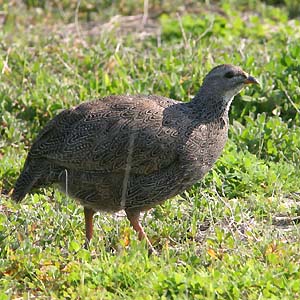
Cape Francolin West Coast NP, South Africa |
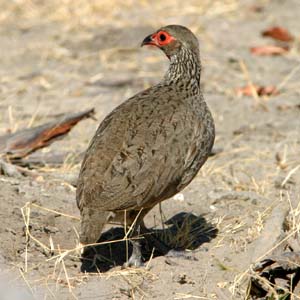
Swainson's Francolin Mahango Game Reserve |
| [Chukar Alectoris chukar [I] | Rita had a couple on Robben Island off Cape Town where they are introduced] | |
| Red-necked Francolin (Spurfowl) Francolinus afer | We saw a small partyat Augrabies Falls NP. This is an isolated population (F. a. xxx) along the Orange River is western South Africa; far-distant from populations to the east (the species ranges from east Africa to eastern South Africa) | |
| Hartlaub's Francolin Pternistes hartlaubi * | NE | This Namibian endemic proved to be very elusive but (when seen) an absolutely great little bird. It is a very small francolin and appears to 'bounce' between boulders atthe base of rocky cliffs. Richard and I saw three (a male & 2 females) in response to his tape at Waterberg NP (Rita chose not to trash cross-country through the thornscrub to chase these down; Richard actually saw one near the same site the next day). Remarkably they did not vocalize at all in response to tapes but suddenly (and very briefly) appeared just in front of us. Another bird was heard by all of us at very close range at Erongo Wilderness Lodge but it somehow 'vanished' between the rocks and none of us saw that one |
| Red-billed Francolin Pternistes adspersus * | NE | After hearing (but not seeing) them in the Erongo Mountains they suddenly became 'tame' and obvious at Namutoni Camp in east Etosha. Others were at Roy's Camp and Mahungo Reserve; they became absurdly tame around our lodging in Waterberg NP where they were almost always on the little lawn behind our bungalow |
| Cape Francolin Pternistes capensis * | E | Heard on several days in theCape Town vicinity (such as Kirstenbosch Gardens) but not actually seen until West Coast NP and in open country around Lamberts Bay |
| Swainson's Francolin Pternistes swainsonii * | NE | Pairs seen in Mahunga Reserve and around Drotsky's Camp on the Okavango |
| Helmeted Guineafowl Numida meleagris | Flocks were common at Kirstenbosch Gardens; around Lamberts Bay; and then daily in Etosha NP (up to 100/day) with more in the Caprivi Strip | |
| Small Buttonquail Turnix sylvatica | A pair were flushed from the drygrassy verge at the bridge crossing the dry bed of the Khan River in northwestern Namibia. As usual only flight views were possible | |
| Blue Crane Anthropoides paradisea | E/
VU |
Scattered pairs of this beautiful crane were in fields during an inland drive between West Coast NP and LambertsBay. These were the only ones seen on the trip |
| Wattled Crane Grus carunculatus * | VU | A pair of this impressive crane were feeding on a flooded plain at the edge of the Okavango River at Mahunga Reserve |
| [ Buff-spotted Flufftail Sarothrura elegans | One was heard at close range along a thicket-lined little stream in the Cape Town vicinity but could not be seen despite efforts. It was not responsive to calls sothis potential lifer 'got away' ] | |
| African Rail Rallus caerulescens * | One showing nicely in the scope along the edge of a small pond in West Coast NP; another heard in wetlands at Mahunga Reserve | |
| Black Crake Amaurornis flavirostris | A few scattered birds here and there: West Coast NP; reeds along Orange River near Upington; the waterhole at Namutoni in Etosha; at the edge of the Kavango River at N'kwazi Camp; and in Mahungo Reserve | |
| Purple Swamphen Porphyrio madagascariensis | One at Strandfontein near Cape Town was it | |
| Common Moorhen Gallinula chloropus | Fairly common on ponds and wetlands throughout | |
| Red-knobbed Coot Fulica cristata | Common on ponds around Cape Town and vicinity |
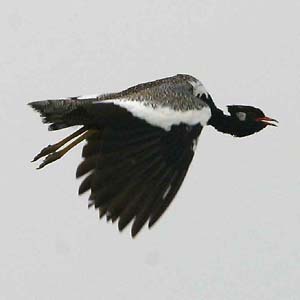
Black Bustard West Coast NP, South Africa |

African Oystercatcher Simonstown, South Africa |
| Ludwig's Bustard Neotis ludwigii * | This was one of my 'top ten most-wanted' so 3 observations of 4 birds was gratifying. A pair was at Nieuwoutville Wildflower Reserve; a single bird flew over karoo near Brandvlei (calling in flight); and one was striding a grassland in Etosha NP. I photograhed all of these. | |
| Kori Bustard Ardeotis kori | The conspicuous bustard in KGNP (up to14/day) and Etosha (up to 12/day). Another pair were simply in open country on the drive from Fish River Canyon to Mariental. It is always fun to encounter these huge birds. | |
| Red-crested Bustard Eupodotis ruficrista * | NE | One male was in Mahango Reserve. |
| Black Bustard Eupodotis afra * | E | We had close encounters with a pair at the north entrance to West Coast NP when Richard played a tape and they came flying in out of nowhere, loudly responding! Another was in a field not far away. Impressive and lovely birds |
| White-quilled Bustard Eupodotis afraoides * | NE | Widespread in small numbers from north of Brandvlei to Etosha NP; seen daily in Etosha but less so farther south with just an occasional pair every other day or so in the interior |
| Ruppell's Bustard Eupodotis rueppelli * | NE | The other bustard in my 'top ten most-wanted' birds for the trip — so we arranged to go as far northwest in Nambia to get into its range. Here in the plains below Spitzkoppe we had 8 birds paired up and doing apparent courtship flights |
| Karoo Bustard Eupodotis vigorsii * | E | Recorded daily around Brandvlei but mostly 'heard-only' birds. They have an amazingly silly low-pitched call. On our first encounter we used tape playback to get distant views of 4 of them. One other was near Fish River Canyon. |
| African Jacana Actophilornis africanus | Common in the Okavango Delta. Single birds seen on ponds in Etosha NP and Daan Viljoen Reserve near Windhoek | |
| Greater Painted-Snipe Rostratula benghalensis | One juvenal was in a tiny rain-puddle in sand dunes near N'kwazi Camp near Rundu | |
| African Oystercatcher Haematopus moquini * | E/
NT |
A few seen most days along the coast near Cape Town |
| Black-winged Stilt Himantopus himantopus | A few seen near the coastat Strandfontein and Lamberts Bay; interior birds were near Fish River Canyon (small pond) and good numbers in the flood plain at Mahango Reserve | |
| Pied Avocet Recurvirostra avosetta | One seen as we crossed an estuary south of Lamberts Bay. We had no time to bird this spot. | |
| Water Thick-knee Burhinus vermiculatus | One pair along the Okavango River near Xaro Camp was it | |
| Spotted Thick-knee Burhinus capensis * | Our 'lifer' was standing ina bare lot adjacent to the parking lot for the Boulders Bay penguin colony. This was a big surprise. One other was seen around the Okaukuejo waterhole in Etosha NP at dusk | |
| Double-banded Courser Rhinoptilus africanus | We encountered this coolbird three times: on the game drive in restored grasslands at Anib Lodge; and during two days in grasslands at Etosha NP | |
| Collared Pratincole Glareola pratincola | A single bird was seen in flight near Drotsky's Camp at Shakawe (Botswana) | |
| Kittlitz's Plover Charadrius pecuarius | A couple in Cape of Good Hope NP; another south of Lamberts Bay | |
| Three-banded Plover Charadrius tricollaris | A few scattered birds on ponds from Lamberts Bay to Avis Dam in Windhoek | |
| Long-toed Lapwing Vanellus crassirostris | One or two pairs encountered daily at Mahango Reserve and along Okavango River; prefers quiet backwater edges | |
| Blacksmith Plover Vanellus armatus | Widespread on wetlands around Cape Town; later seen daily at Etosha NP and through Caprivi Strip to Okavango River | |
| Crowned Lapwing Vanellus coronatus | Common on dry interior grasslands and in scrub country; daily in KGNP and Etosha and Mahango Reserve with a few individuals elswhere in the interior |
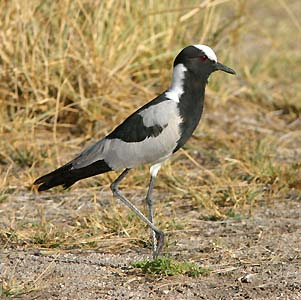
Blacksmith Plover Etosha NP |
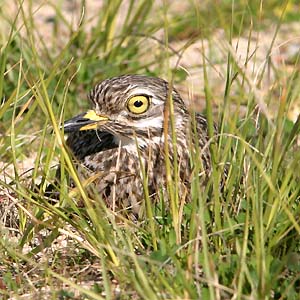
Spotted Thickknee Simonstown, South Africa |
| Common Greenshank Tringa nebularia | A single summering bird was a Cape of Good Hope NP (in the austral winter); four more non-breeders were standing on a sandbar in the Okavango River | |
| Wood Sandpiper Tringa glareola | One non-breeder seen from roadside at an estuary south of the Lamberts Bay (didn't have time to scope here; could have been more about) | |
| Common Sandpiper Actitis hypoleucos | One non-breeding was summering on a sandbar in the Okavango River | |
| Ruddy Turnstone Arenaria interpres | Three summerers flew past our 'shark boat' anchored in the lee of Dyer Island | |
| Snowy Sheathbill Chionis alba * | Two in Cape Town harbor where they were very skittish and hard to observe. We eventually got close to one; more details of the 'chase' on the trip report Introduction page. Thisis a species of subantarctic islands and the Antarctic Peninsula. During the southern winter birds disperse widely away from breeding grounds; thesemovements regularly take individuals to southern South America. It is during this season (June-July) that birds turn up on the South African coast.It seems likely that most (all?) were transported to some extent aboardships but it is also very likely none were kept forcibly on the ships. The birds we saw flew well; were anything but tame; and showed no signs of any involuntary captivity. Locals in South Africa consider them vagrants that are counted on the National list; indeed there were birders with uswho had flown from J'berg to chase these birds. One sheathbill had arrived in Cape Town harbor about 10 days before we did; the second just a fewdays earlier. Under these circumstances we felt they were 'countable' vagrants comparable to most records of coastal boobies in California. It is probable that most (all?) Red-footed Boobies recorded in California rode some ofthe distance on masts or the railings of ships as they commonly do offshore. No one objects to this as an obstacle affecting the 'countability' of Red-footed Booby in California. | |
| Subantarctic Skua Catharacta antarctica * | About a dozen were chasingabout through the swarms of seabirds following the offshore trawler onthe pelagic trip | |
| Kelp Gull Larus dominicanus | Common along the coast (over 100/day onmost days). All were the local subspecies vetula that is consideredby some to be a separate species: the near-endemic "Cape Gull." I am unawareof any significant authority that accepts this split nor have I read anyarguments that support it. All major world listings lump it with the widespreadSouthern Hemisphere L. domincanus. | |
| Hartlaub's Gull Larus hartlaubii * | E | Abundant along the coast (100+every day there). It fills the 'small gull' niche that is divided by severalspecies in California (for just one example). This was the first 'lifer'encountered: at the Cape Town airport |
| Great Crested Tern Sterna bergii | A few seen most days along the coast(up to 20 on the pelagic trip). Called "Swift Tern" locally | |
| Antarctic Tern Sterna vittata * | Two in basic plumage flew by our 'shark' boat anchored off Dyer Island; they seemed heavier-billed and more stout-bodied than my recollections of Arctic Tern. | |
| Arctic Tern Sterna paradisea | Two more Sterna terns were seen on the pelagic trip but the one that came closest was in full alternate plumage. I managed one photo that was posted on-line. Several expert commentators replied that the photographed bird was Arctic Tern S. paradisea. The bird does look thin-billed and light-bodied in the photo but should an ArcticTern be in alternate plumage in the southern hemisphere at this date? Mysteries abound. For the moment, we'll go with expert opinion. Do you have comments? | |
| Whiskered Tern Chlidonias hybridus | Lots of non-breeders (80) were roosting in one back-channel off the Okavango River | |
| African Skimmer Rhynchops flavirostris | NT | A flock of ~30 was roosting on a sand bar in the Okavango River downstream from Xaro Lodge. One other flew by the boat farther upstream the next day. |

Namaqua Sandgrouse Etosha NP |
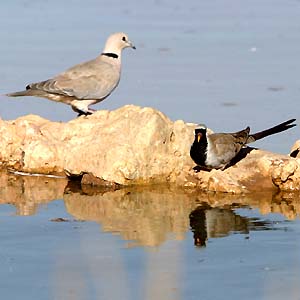
Cape Turtle Dove & Namaqua Dove waterhole, Kalahari-Gemsbok NP |
| Namaqua Sandgrouse Pterocles namaqua * | NE | This was the common inland dry-country sandgrouse from Brandvlei through Etosha and Waterberg. Usuallyseen in small flocks (but we had up to 50/day at times) overhead; greatviews on the ground were obtained at various park waterholes in KGNP and Etosha. |
| Double-banded Sandgrouse Pterocles bicinctus | Flocks (up to 50/day) came to the waterhole at Okaukuejo in Etosha both evenings we were there | |
| Burchell's Sandgrouse Pterocles burchelli * | NE | A very skittish group of 10 circled a tiny waterhole at mid-day in KGNP; we waited 20 minutesor so until they landed — and then only very briefly. Another 8 were drinking mid-morning at the waterhole at Namutoni Camp in Etosha |
| Rock Pigeon [I] Columba livia | This non-native pigeon was feral in cities and larger towns in South Africa and Namibia | |
| Speckled Pigeon Columba guinea | Common and widespread around the Cape.Declining numbers inland through the karoo to KGNP; encountered in Namibia only around Windhoek and out to the Erongo Mts | |
| Rameron Pigeon Columba arquatrix | A few flew overhead while we searched for Knysna Warbler in the Constancia greenbelt on the back side of Table Mountain | |
| Laughing Dove Streptopelia senegalensis | Common and widespread throughout the interior; smaller numbers around the Cape but still ubiquitous |
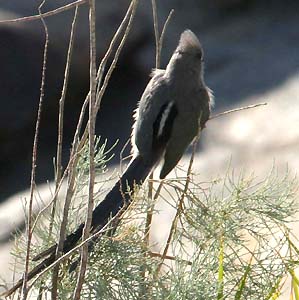
White-backed Mousebird [showing back] Augrabies Falls NP |
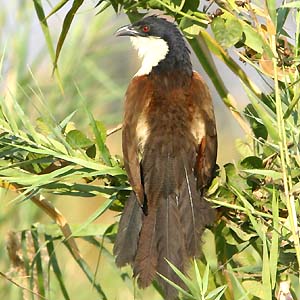
Coppery-tailed Coucal Okavango Delta |
| African Mourning Dove Streptopelia decipiens | Regular in the woods around Drotsky's and Xaro camps; a pair courted over our lodging at Xaro every morning | |
| Ring-necked Dove Streptopelia capicola | The abundant arid country dove from Brandvlei through the Caprivi Strip; peak numerbs (200+/day) werein KGNP | |
| Red-eyed Dove Streptopelia semitorquata | "I-am-a-Red-Eyed-Dove" was an ever-present background vocalization through the Cape area and in thekaroo; dropping off significantly in desert habitats (where the preceding species takes over). Common again in the Okavango Delta and in agricultural areas around Windhoek | |
| Emerald-spotted Wood-Dove Turtur chalcospilos | A few seen daily scuttling in the undergrowth in the woods along the Okavango River | |
| Namaqua Dove Oena capensis | Common and widespread in arid desert countryfrom Augrabies Falls and KGNP through Etosha; smaller numbers encountered in the Caprivi Strip and vicinity (e.g. Mahango Reserve) | |
| African Green-Pigeon Treron calva | A flock of 20 or so were feedingon a fruiting tree at Xaro Camp in Okavango Delta | |
| Meyer's Parrot Poicephalus meyeri | A few pairs encountered in Caprivi Strip and at Drotsky's on Okavango | |
| Ruppell's Parrot Poicephalus rueppellii * | NE | This essentially Namibian endemic was seen twice: four feeding in a thick tree along the dry Khan River bed near Erongo Mts., and 3 more feeding in a flowering tree at Waterberg NP |
| Rosy-faced Lovebird Agapornis roseicollis * | NE | Parties of these cute little lovebirds were around Spitzkoppe and Erongo Wilderness Lodge; a few more were in Waterberg NP |
| Gray Go-away-bird Corythaixoides concolour | Common and widespread in wooded country across northern Namibia and Botswana | |
| Coppery-tailed Coucal Centropus cupreicaudus * | Regular but retiring in reeds and papyrus along the Okavango River. Our 'lifer' was sitting up and calling near dusk and watched from Nkwaza Camp on the river; ironically the bird itself was sitting in reeds in Angola! So we have a life bird from Angola without ever having been there . . . | |
| Barn Owl Tyto alba | Two adults and two youngsters were spot-lightened during a night drive in KGNP. They were at a nest built inside a Social Weaver nest. Another was in Etosha NP |
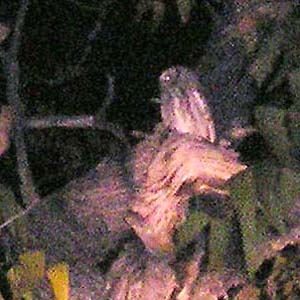
African Scops-Owl Halali Camp, Etosha NP (at night) |
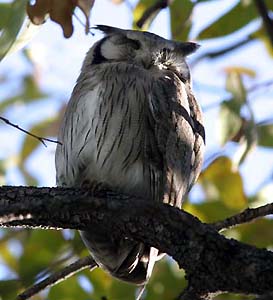
Southern White-faced Owl Halali Camp, Etosha NP (day roost) |
| African Scops-Owl Otus senegalensis * | Richard called one in for fine views with a tape after dinner at Halali Camp in Etosha NP. This widespread species had long eluded me; this one proved to have a territory very close to our bungalow | |
| Southern White-faced Owl Ptilopsus granti * | One was spot-lighted during a night drive at KGNP as it sat in a tall tree. Another was found at a day roost at Halali Camp in Etosha NP | |
| Spotted Eagle-Owl Bubo africanus | This is clearly the common large owl in the Kalahari Desert: we saw six (!) during one night-drive in KGNP. Two others were found at day roosts there | |
| Verreaux's Eagle-Owl Bubo lacteus | Two were seen at KGNP: one at a day roost (spotted by Richard) and the other during one of park's night drives | |
| Pel's Fishing Owl Scotopelia peli | This much sought-after big orangeowl was nicely seen at a known day roost at Xaro Camp in the Okavango Delta. A pair has long resided and bred here. The proprietors are very carefulto space out tourist's visits to the roost to avoid any undue or prolonged disturbance. So far this works very well. This was a lifer for Rita; Don had seen one previously at a day roost below Murchison Falls in Uganda | |
| Pearl-spotted Owlet Glaucidium perlatum | Common and widespread in arid country inland; we saw a dozen birds during the day at KGNP and Etosha and around Spitzoppe. Richard often hooted its call to attract dicky-birds. Several times the owl responded and came in. At other times we found a day-hunting owl because of the mob of little birds around it | |
| African Barred Owlet Glaucidium capense * | It must be common in woods on the Okavango River as Richard was able to get responses from owls in such degraded woodland patches as Mahango Reserve and Xaro Camp. Those of us with Richard each time ended up seeing both owlets | |
| Fiery-necked Nightjar Caprimulgus pectoralis | The "good-Lord-deliver-us"calls were heard throughout the night at N'kwazi Camp near Rundu. The wooded patch was very degraded but they were in it anyway; this species is apparently resident in the Caprivi Strip. A nightjar without white in the tail (but with a wing patch) was flushed in dry Brachystegia woods west of Rundu. It flew to a limb and perched; scope views showed a rufous hindcollar. Some points better fit Rufous-cheeked Nightjar C. rufigena (a potential lifer that summers here) but the mid-winter date argued against that i.d. Apparently this population migrates to the Congo Basin in winter. So it was more likely C. pectoralis . . . | |
| Freckled Nightjar Caprimulgus tristigma | Several heard calling all night at Erongo Wilderness Lodge. Having seen this species well before (in Gabon) we did not chase after the singing birds | |
| Square-tailed Nightjar Caprimulgus fossii | Two were foraging over the Okaukuejo waterhole in Etosha NP throughout our first evening there | |
| African Palm-Swift Cypsiurus parvus | Colonies of these swifts were widely scattered throughout the interior; almost always within the immediate vicinity of native or introduced palms | |
| Alpine Swift Tachymarptis melba | Common over Augrabies Falls and then seen once more at Erongo Wilderness Lodge | |
| Bradfield's Swift Apus bradfieldi * | Small flocks (~30) were over Fish River Canyon and a couple more seen over the cliffs of the Waterberg Plateau.Richard was surprised we did not see more at places like Augrabies Falls but perhaps some populations withdraw northward in winter | |
| Little Swift Apus affinis | Mostly an urban species: colonies (up to100 in some spots) were seen in interior towns and cities throughout | |
| White-backed Mousebird Colius colius * | NE | Common in thornscrub of the interior from Brandvlei to Etosha and Waterberg parks. Our first dozen were encountered in coastal scrub on the coast at West Coast NP |
| Speckled Mousebird Colius striatus | Patchily seen along the coast inthe Cape vicinity; mostly in suburban habitats | |
| Red-faced Mousebird Urocolius indicus | A small party of 8 visited thegrounds of Canyon Lodge (near Fish River Canyon); another small party wasin the Caprivi Strip |
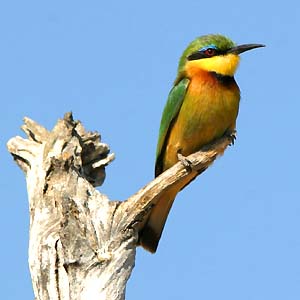
Little Bee-eater Mahango Game Reserve |
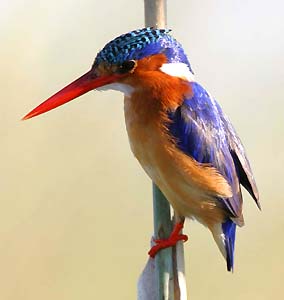
Malachite Kingfisher Okavango Delta |
| Malachite Kingfisher Alcedo cristata | Common in reeds along the Okavango River in Botswana | |
| Striped Kingfisher Halcyon chelicuti | Only a couple encountered in deciduous woods in the Caprivi Strip | |
| Giant Kingfisher Megaceryle maxima | Conspicuous but not common (max 3/day) on the Okavango River in Botswana | |
| Pied Kingfisher Ceryle rudis | Very common along the Okavango River; a very few others encountered elsewhere (including the Boulders Bay penguin colony) | |
| White-fronted Bee-eater Merops bullockoides | Common on the Okavango River in Botswana. Usually in colonies perched on tree roots and branches near nesting holes in vertical mud banks (although the nest sites werenot in use in winter) [In the summer S. Carmine Bee-eaters M. nubicoidesalso use the riverbank burrows] | |
| Little Bee-eater Merops pusillus | Common and widespread along the Okavango River; including throughout the Caprivi Strip. This bee-eater exists in degraded habitat not frequented by other bee-eaters | |
| Swallow-tailed Bee-eater Merops hirundineus | Regularly encountered in small numbers (max 8/day in KGNP) in the Kalahari Desert and other similar arid habitas (a few near Uis; at Mahango Reserve; and near Windhoek) | |
| Lilac-breasted Roller Coracias caudata | Widespread in small numbers (max 7-8/day) in arid country from the Kalahari through the dry savanna in Etosha NP and in the Caprivi Strip | |
| Rufous-crowned (Purple) Roller Coracias naevia | There was one day in KGNP that they seemed everywhere (10/day) but after that just a few scattered birds there. Also a few in Etosha and Caprivi Strip | |
| African Hoopoe Upupa africana | This crowd favorite was widespread but not common (max 5/day in Etosha); mostly encountered in KGNP, Etosha, and in the Caprivi Strip. One engaging bird was feeding vigorously on the ground outside our Okaukuejo chalet and permitted close-range photography (below) |
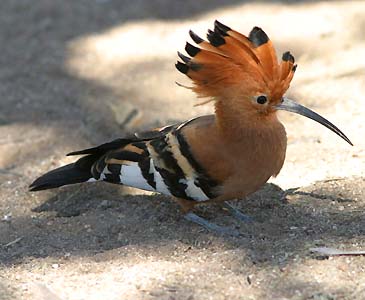
African Hoopoe Okaukuejo Camp, Etosha NP |
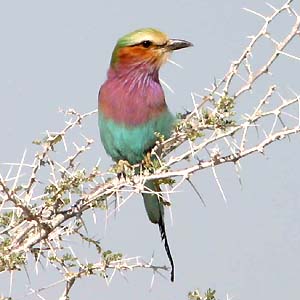
Lilac-breasted Roller Etosha NP |
| Green Wood-hoopoe Phoeniculus purpureus | A few daily in the woods aroundXaro Lodge on Okavango River | |
| Violet Wood-hoopoe Phoeniculus damarensis * | Six wood-hoopoes in a mixed flock of babblers and buffalo-weavers were chased through the dry woods along the riverbed of the Khan River in northwest Namibia. Althoughvery vocal the views were never sterling. Yet we did get a few observations in good light that showed the violet sheen well. This is one of the few regions in all of Africa where this is the common species instead of the previous one | |
| Common Scimitarbill Rhinopomastus cyanomelas | Singles were seen or heard on 8 days in the interior; they always were restless and on-the-move. Locales included Augrabie Falls NP, KGNP, Etosha, and Caprivi Strip | |
| Damara Hornbill Tockus damarensis * | NE | This taxon is newly split from the next species by some recent authorities. It resembles Red-billed but has a pale unmarked face and a dark eye (as opposed to a cheek patch anda pale eye). The two separate out geographically and ecologically. This is the small hornbill of arid thornscrub and riverine woods in northwestern Nambia and southwestern Angola. We saw 3 in woods along the dry Khan River bed and a dozen or so more in the drier western portion of Etosha NP (Okakauejo area) |
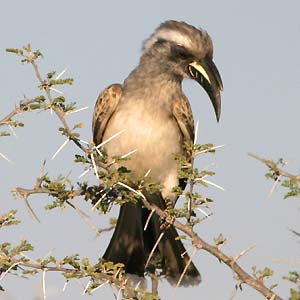
African Gray Hornbill Etosha NP |

Red-billed Hornbill Halali Camp, Etosha NP (digiscoped) |
| Red-billed Hornbill Tockus erythrorhynchus | This widespread African species was seen only at Halali Camp in central Etosha NP; scope views there separated it from the preceding species that occurs west of here. Richard says he has seen 'intermediates' that cloud the taxonomic picture. This is a common species in eastern Africa | |
| Monteiro's Hornbill Tockus monteiri * | Although not strictly an endemic, this hornbill has a limited range and was therefore highly prized. We had fine views (and photos) around Erongo Wilderness Lodge in northwest Namibia. A few others were at Avis Dam and Daan Viljoen Reserve outside Windhoek | |
| Southern Yellow-billed Hornbill Tockus leucomelas | NE | Common and widespread in dry thornveld of the interior. Recorded daily from KGNP and throughout Namibia (absent in the Okavango Delta we visited) |
| Bradfield's Hornbill Tockus bradfieldi * | Another specialty hornbill we wanted: finally seen nicely in the Caprivi Strip | |
| African Gray Hornbill Tockus nasutus | Common and widespread in dry savanna and deciduous woods of northern Namibia and Botswana. Seen daily from Windhoek north (up to 10/day is Etosha NP) |

Crested Barbet (female) Xaro Camp on Okavango River |
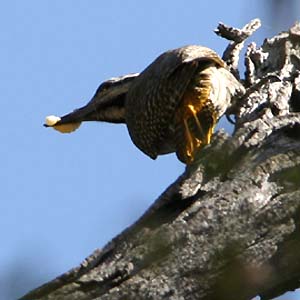
Bearded Woodpecker Mahango Game Reserve |
| Yellow-fronted Tinkerbird Pogoniulus chrysoconus | One high in the canopy at Drotsky's on Okavango River | |
| Pied Barbet Tricholaema leucomelas | NE | Encountered in small numbers in thornscrub habitat from Augrabies Falls and KGNP to Etosha and the Caprivi Strip. Best views (and photos) at Waterberg NP. A personable little barbet |
| Black-collared Barbet Lybius torquatus | Regular in the patches of woods on the Okavango River (Drotsky's and Xaro) | |
| Crested Barbet Trachyphonus vaillantii | Single birds in woods at Xaro Camp and in Mahango Game Reserve | |
| Lesser Honeyguide Indicator minor | The only honeyguide of the trip was in the woods around Xaro Camp | |
| Bennett's Woodpecker Campethera bennettii | Seen at Erongo Wilderness Lodge and the woods around Xaro Camp | |
| Golden-tailed Woodpecker Campethera abingoni | The only one of the trip was at Augrabies Falls NP | |
| Cardinal Woodpecker Dendropicos fuscescens | This little woodpecker was patchily distributed throughout the interior (Augrabies Falls, KGNP, Spitzkoppe) but was recorded daily in Caprivi Strip and Mahango Reserve | |
| Bearded Woodpecker Dendropicos namaquus | A single male in a big fig tree at Mahango Reserve was the only one we saw |
|
PAGE 2 OF BIRD LIST [Passerines] |
|
|
|
|
|
|
|
|
|
|
|
|
|
|
PHOTOS: All photos on this page are © 2005 Don Roberson; all rights reserved. Many other shots from this trip are scattered about this web site. Check particularly bird families, mammals, and herps listings.
Literature cited:
Beresford, P., F.K. Barker, P.G. Ryan, and T.M. Crowe. 2005. African endemics span the tree of songbirds (Passeri): molecular systematics of several evolutionary 'enigmas'. Proc. R. Soc. B 272: 849-858.TOPDickinson, E., ed. 2003. The Howard & Moore Complete Checklist of the Birds of the World. 3d ed. Princeton Univ. Press, Princeton, N.J.
Sinclair, I., P. Hockey, and W. Tarboton. 1993. Illustrated Guide to the Birds of Southern Africa. New Holland, London.
GO TO LIST OF BIRD FAMILIES OF THE WORLD